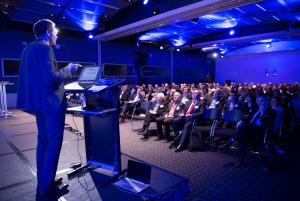On 1 February 2017, 160 delegates from the entire PET value chain from Europe and beyond convened in Brussels for the annual PETCORE EUROPE Conference 2017.
Under the theme “PET 2020 – The future of the PET industry”, the complete industry - from PET resin producers, masterbatch producers, packaging designers and manufacturers, equipment manufacturers, label producers to major brand owners, EPR schemes, waste management organisations, recyclers, waste sorting and recycling machinery manufacturers - presented and shared their visions on the future of PET and the PET industry.
Additionally, speakers from the European Commission, the European Environmental Bureau and the Ellen MacArthur Foundation gave an outlook on the development of the Circular Economy and other environmental challenges ahead.
"In all its ongoing activities, PETCORE EUROPE is already well engaged as a significant contributor to the Circular Economy," emphasised Patrick Peuch, Executive Director of PETCORE EUROPE, who moderated the event. "PET is one of brand owners’ packaging materials of choice due to its outstanding performance in safely delivering products and its recyclability." However, the PET value chain is also facing major challenges that were reflected in the conference debates.
PET Packaging 2020
From the PET producers’ side, Antonello Ciotti, Vice President of CPME (Committee of PET Manufacturers in Europe) started with a business overview on PET global demand and the European market. He also emphasised the reasons why PET is one of the most sustainable packaging materials: beverages and food protection avoiding wastage, resource savings due to light weight, outstanding LCA and carbon footprint, and its full recyclability. He also presented the challenges posed by the Circular Economy, including shifting from fossil to bio-based PET. These challenges will require innovation from all actors and the PET producers are committed to take part in this effort.
Nicolas Rivollet from Husky and Carsten Lauridsen from Faerch Plast focused their respective presentations on the trends in PET packaging and design, while illustrating past and future developments. "In 2020 we expect to see 5% more bottles per ton of PET in a bale of recycled bottles: this results from the combination of the slow to negative growth of Carbonates Soft Drinks, an increased share of low volume formats and resin efficiency gains for a given format,” explained Rivollet. "Small CSD, Juice Sport Drinks & Teas, liquid dairy, home, personal care and food packaging currently represent the next frontier for PET: these applications require more engineered PET packages and the number of those packages could double by 2020." Lauridsen showed a spectacular vacuum skin packed sirloin with a shelf life increase from 6 to 16 days and a food waste reduction from 34% to 18% in stores.
Finally, leading brand owners outlined their perspective on PET packaging and sustainability. Gian de Belder and Johannes Burghaus from Procter & Gamble as well as Françoise Poulat from Danone explained their respective companies' sustainability packaging solutions and innovations. P&G presented a range of new packaging such a PET aerosols and its new Head and Shoulders shampoo bottle made from recycled plastics collected from beach clean-ups. Danone emphasised their efforts in using recycled PET, while insuring food safety compliance, using eco-design tools in new projects, and considering bioplastics in the future.
PET Sustainability 2020
During the afternoon session, speakers from the European Commission, the European Environmental Bureau and the Ellen MacArthur Foundation were invited to give an outlook on the future environment in which the PET industry will operate. Focusing on the implementation of a Circular Economy, they emphasised the need for increasing recycling rates and also discussed critical environmental challenges such as marine litter.
In this context, Eric Liégeois from the European Commission presented the recently published roadmap for the Strategy on Plastics in a Circular Economy, currently open for public feedback. He emphasised the three critical interrelated issues outlined in the strategy: the high dependence on fossil feedstocks, the low rate of recycling and reuse of plastics in general, and the significant leakage of plastics into the environment.
Stéphane Arditi from the European Environmental Bureau insisted on the implementation of deposit systems to encourage consumers to pull together with the industry. "If you want to put responsibility on the consumers, you have to raise awareness by touching their wallets and consider a deposit system," Arditi outlined.
Sander Defruyt from the Ellen MacArthur Foundation concluded the session with his presentation on the New Plastics Economy, which had been recently presented during the World Economic Forum at Davos, where 40+ business and government leaders endorsed a global action plan on plastic packaging. "Three strategies are needed to transform the global plastic packaging market: fundamental packaging re-design and innovation, reuse systems and recycling with radically better economics and quality," he pointed out.
"59% of PET bottles were collected and recycled in Europe in 2015," outlined An Vossen from EPRO/Plarebel in her presentation. "But what about other PET applications, like trays or opaque and difficult to recycle containers that represent significant recycling challenges?" She further emphasised that the common practice of "cherry picking" the most recyclable fraction from the complete plastic waste has to stop. "We have to adapt our collection and recycling systems, and have to make sure that all plastics waste is recycled," said Vossen further. "In order to implement such a Circular Economy, packaging and recycling cannot be looked at in isolation, you need to combine innovation and recycling.”
From the recyclers’ perspective, Casper van den Dungen, Vice President of the Plastics Recyclers in Europe (PRE), clearly emphasised that a lot has to be still implemented to meet the European Commission's 2025 target proposal of 55% recycling rate for the complete plastic waste stream in the EU. PET bottle recycling is best in class today with more than 55% recycling rates. "However, for achieving these overall targets for all plastics and packaging, the most important thing is that the right infrastructure is in place, which is not yet the case," he stated during his presentation.
PETCORE EUROPE Conference 2018
The next PETCORE EUROPE Conference will take place in the first quarter of 2018. The exact date and place will be announced in the second half of 2017.
Contact, pictures & conference papers
To view all conference pictures from the venue, the speakers and participants, please visit our album here: https://goo.gl/photos/ZmH8A1UA8XijQoJG9.
To view the complete press release, please check our press room here.


